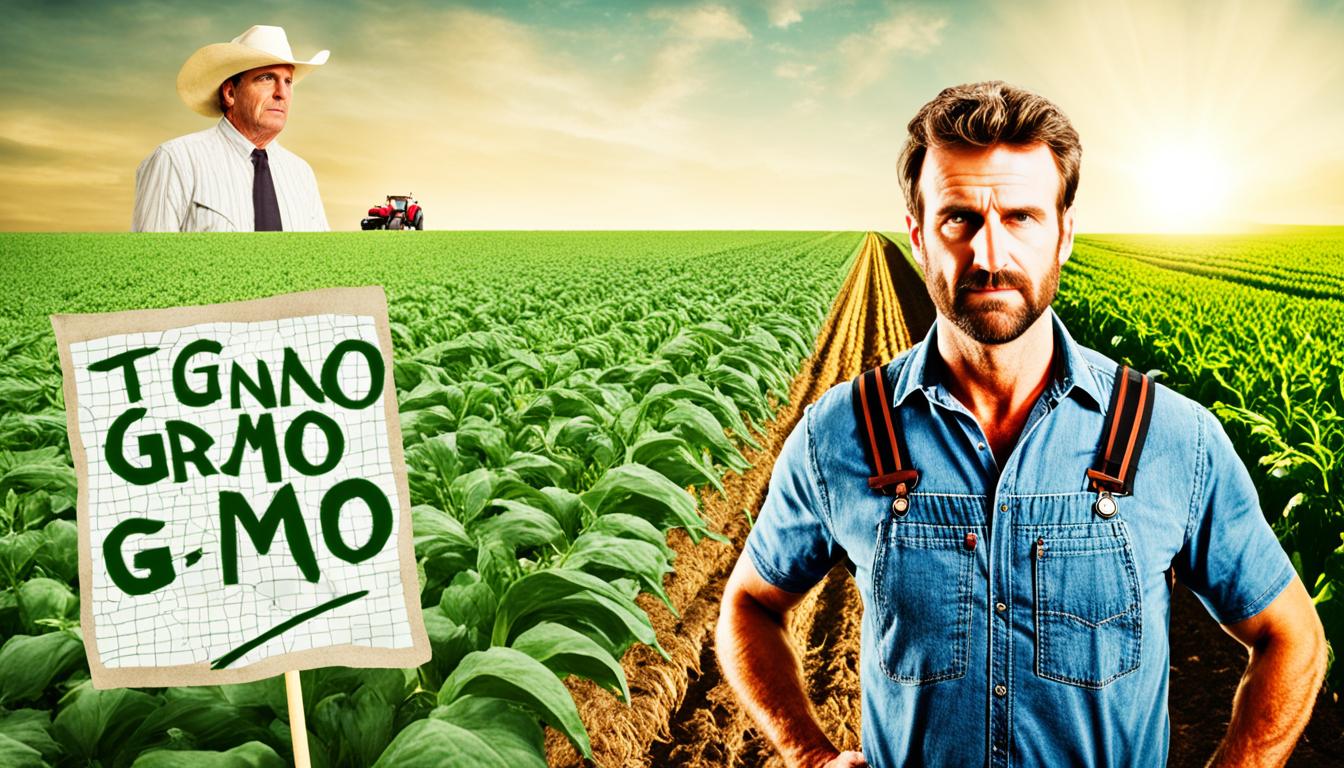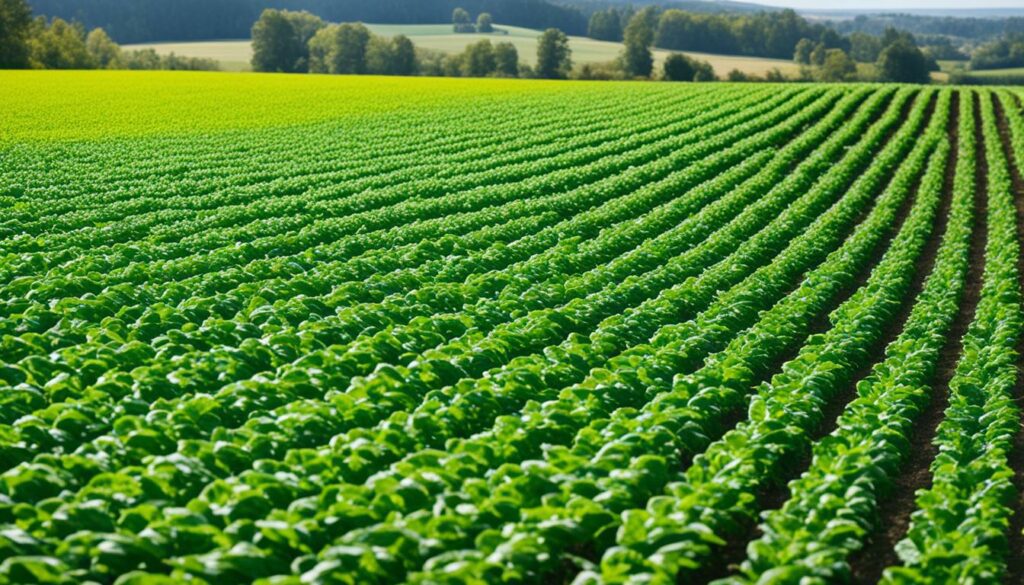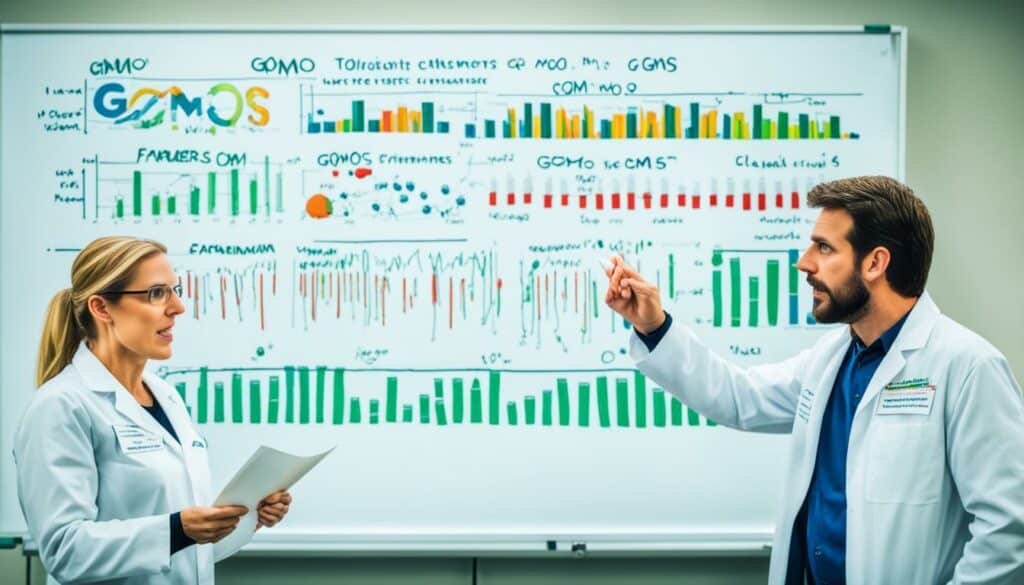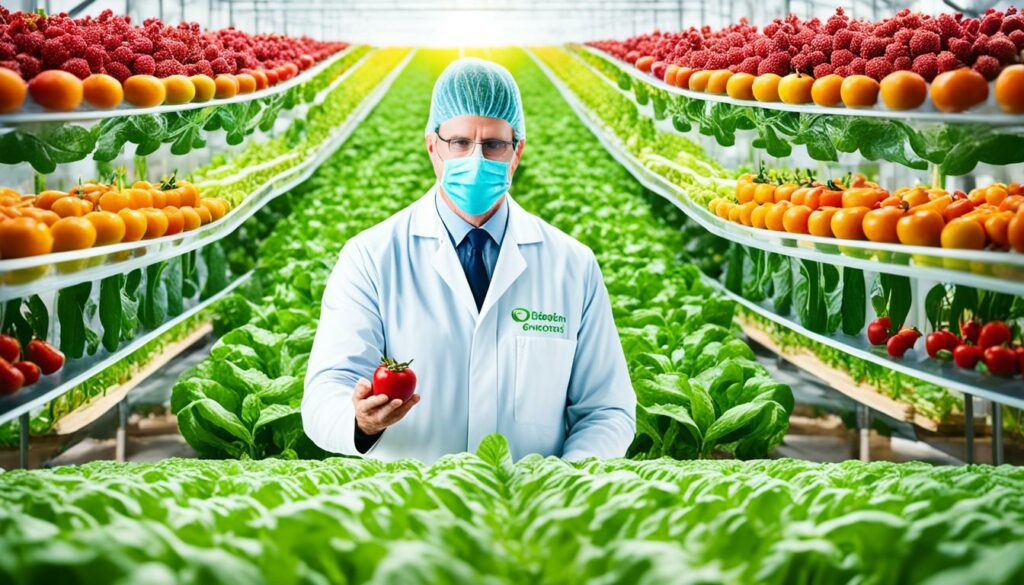Menu

Did you know that using genetically modified insect-resistant corn in America has cut down insecticide use? This big change happened over the last twenty years. GMOs make a huge difference in farming. The debate is complex. It touches on food safety, growing crops worldwide, and how to farm sustainably.
There are differing opinions. Dr. Sarah Evanega praises GMOs for being safe and helping small farmers. At the same time, Dr. David Perlmutter is worried about the health and environmental risks. The world’s population is set to grow by 2050. So, finding good ways to farm is more important than ever. These talks look at the mixed views and many sides of GMO use in farming. It discusses how GMOs can help fight hunger but also their effect on the planet.
Genetically modified organisms (GMOs) have truly changed farming today. We now use science to tweak plants and animals’ DNA. This gives us crops and livestock that are hardier, healthier, and more productive.
Imagine taking genes from a fish and giving them to a tomato. This is what GMOs do. They’re living things with altered DNA to get special traits. These traits help feed us better, like resisting pests or having more vitamins.
In 1994, the world saw its first genetically engineered crop, the Flavr Savr tomato. Soon after, more GMO crops entered our fields. Today, these special plants are everywhere, bringing big changes to how we farm.
Research shows us the many effects GMOs have had since they started in the 1990s. They’ve changed farming, nature, and even our wallets. Despite the benefits, some challenges, like super weeds, have popped up.
| Year | Event | Impact | t
|---|---|---|
| 1994 | Flavr Savr tomato introduced | First GM crop in the food supply | t
| 1996-2012 | Widespread GM crop adoption | Agronomic, environmental, and economic changes | t
| 2013 | ISAAA Brief No. 46 report | Significant global impact of GM crops | t
GMOs have had victories and spurred many talks. They’ve surely made their mark on agriculture. Yet, their story is still being written, with new chapters on how we’ll deal with challenges.
Genetic modification is changing how we farm. It lets us make plants that grow better and fight off diseases. This is done by changing the plants’ DNA so they have special features. These features help them deal with problems in the fields. It’s all part of helping farmers be more successful.
Scientists use clever methods like CRISPR and gene splicing to change plant DNA. CRISPR lets them change the DNA very accurately. With this, they can fix problems or add new abilities to plants. Gene splicing brings genes from different plants together. This makes new plants with the best traits from each. It was found in a study that a lot of these new plants showed the changes. This shows how powerful these methods are.

There are many genetically modified crops. Each one is made to solve a certain problem in farming. For instance, Bt corn can fight off insects by itself. This helps farmers use fewer pesticides, which is good for the environment. Another is Golden Rice. It has much more vitamin A than regular rice. This can help stop vitamin A shortages in places that rely on rice. Also, putting a special protein in maize has mostly worked. This could make corn safe from certain diseases.
| Genetic Modification Example | Benefit | Reference |
|---|---|---|
| Golden Rice | 23.3x increase in vitamin A | Beyer, 2002 |
| Bt Corn | Pest resistance | Various studies |
| Transgenic Maize | 80% success in expressing viral protein | Guerrero-Andrade, 2006 |
In Europe, GM crops are worth more than non-GM ones. This shows they can be very beneficial (Demont, 2007). Think of salmon that grow faster because they are genetically changed. This is another way GM can help, even beyond plant farming. All these discoveries prove there is a lot of potential in using DNA technology in farming. It promises a future where we have plenty of safe and healthy food.
Genetically Modified Organisms (GMOs) have made big changes in farming. They have helped farmers produce more food and make it more secure. By using biotechnology, GMOs have made crops produce more and better food.
GMOs are great at making crops grow better. They are designed to resist pests and survive without much water. This means farming is more efficient.
A review from 1996 to 2012 shows that GM crops have helped increase income and production worldwide. However, there are doubts that traditional farming alone can feed everyone in the future.
GMOs also make food more nutritious. Take Golden Rice, for instance. It has been designed to help fight Vitamin A deficiency. This type of rice can really make a difference in places where people lack Vitamin A.
A study in the British Medical Journal in 2011 found that Vitamin A can save lives and eyesight in children. So, GMOs are not just about more food; they’re about healthier food that can improve lives. They fight hunger and help keep people well.
GMOs have the power to change farming for the better. They increase how much we can grow and make what we grow healthier. By using biotechnology, we take a big step towards solving food security problems around the world.
When diving into genetically modified organisms (GMOs), we must look at the worries and dangers carefully. Critics say GMOs bring big risks to the environment and our health.
The top worry with GMOs is the environmental risks they might carry. Muir and Howard found that GMOs could interfere with how organisms mate. This may cause problems in nature that we can’t predict.
The use of Bt corn, a genetically modified crop, has also caused concern. Studies, like that of Sears et al., suggest it might harm monarch butterflies. This shows the ecological concerns GMOs raise.

When talking about public health implications of GMOs, things get heated. The herbicide glyphosate, linked to GMOs, makes people question food safety. Even though the FDA ensures GMO foods are safe, many are still unsure.
The possible health effects from eating GMOs are a big debate. Scientists are trying to find out if there are any long-term risks. An important goal is to make sure GMOs are thoroughly checked for safety.
Critics argue that GMOs have positives but also big risks. As Hoban highlights, people are very worried about the bad sides of GMOs.
It’s crucial to deal with GMOs’ environmental and health dangers. This way, we can make smart choices about their use. We need to carefully look at these risks and find ways to use biotechnology safely.
The effect of GMOs on small farmers has pros and cons. It’s key to look at both to understand their place in farming. GMOs increase crop production and cut down on the need for pesticides. Though, there are challenges like how to fit GMOs into traditional farming ways.
A study from 1997 found that GMO crops raised farmers’ yields. For example, Bt corn could yield 160.4 bushels. This is more than non-GMO seeds, which yielded around 147.7 bushels. More crops mean more money for the farmers.
Using less pesticide can also save farmers money. The same study showed farmers used less pesticide, but more glyphosate. It was still cheaper. GMO soybeans brought in around $208.42 per acre, compared to $191.56 from non-GMO soybeans. This change is good for the farmers.
But, there are challenges too. The deals farmers make with seed companies can be tough. They often can’t save seeds or face tough rules if they have a problem. GMO seeds are also very pricey, especially in poorer regions.
Then, there’s the environment. Some weeds and insects get resistant to the GMOs. To fight this, farmers need to have special field areas. The EPA requires this. But, it adds more work for the farmers.
While GMOs can help farmers make more money, getting them is not always easy. Overcoming these issues is important. It helps GMOs be more useful for farming.
| Factor | Benefit | Challenge |
|---|---|---|
| Increased Crop Yields | Higher productivity (Bt corn: 160.4 vs 147.7 bushels) | Cost of GM seeds |
| Reduced Pesticide Use | Lower operational costs | Glyphosate increase |
| Economic Impact | Net value of GM soy: $208.42/acre | Legal restrictions (e.g., no saved seed) |
| Environmental Concerns | Use of refuge areas to prevent resistance | Integration of refuge areas |
| Market Forces | Potential for higher revenues | Accessibility issues |
GMOs have caused heated arguments about their effect on the environment. People both for and against GMOs have strong points. They focus on the impact on pesticide use and the health of the soil.
Genetically modified crops can cut down on pesticide use, helping the planet. Between 1996 to 2018, the use of pesticides on these crops globally fell by 8.3%. This cut saved 775.4 million kg of pesticides. GM crops that resist insects use less insecticides. For example, maize farmers using resistant seeds used 11.2% less insecticide than those without. But, herbicides have seen more use because of GM crops.In the US, GM crops needed 24% more pesticides than non-GM ones by 2011. GM soybeans caused a 28% rise in herbicide use. So, the impact of GM crops on pesticide use isn’t just positive.

| Country | Herbicide-Resistant Weed Species | EIQ Improvement |
|---|---|---|
| US | 17 | 18.5% |
| Canada | 8 | 18.5% |
| Brazil | 9 | 18.5% |
Keeping soil healthy is key for long-term farming. The effect of GMOs on soil health is mixed. Some GM crops help make the soil better. They allow farmers to till less, reducing erosion and keeping soil moist. But, there are worries about using herbicides like glyphosate on these crops.In Canada, herbicide sales went up by 234% between 1994 and 2020, all because of GM crops. The spread of weeds that resist herbicides has made managing soils harder around the globe. These super weeds hurt crop growth and make farming more expensive.
GMOs are at the heart of today’s quest for eco-friendly farming. They offer new ways to tackle farming issues. Thanks to biotechnology, these crops are changing the game in sustainable agriculture.
One key way GMOs promote sustainable farming is by cutting down on chemicals. For example, Bt corn needs less pesticide, reducing harm to the environment. Also, special crops that can fix nitrogen help cut the need for harmful fertilisers. These changes help the planet and save farmers money. The ISAAA Brief No. 46 shows how important GMO crops are for our future.
While GMOs play a big part, there are other sustainable methods, too. Organic farming focuses on keeping the soil and wildlife healthy. Even though it may yield less, its care for nature is vital.
Crop variety and agroforestry are other strong practices. They make farms more resilient to climate change. The Food and Agriculture Organization of the United Nations believes mixing these with new farming ideas leads to a better future.
The way people see GMOs in farming is strongly linked to how the media talks about them. Stories in the media have a big impact on what the public thinks. This is true for both traditional news outlets and newer social media sites.

News stories about GMOs have been on the rise in traditional media. This coverage has changed how people view the usefulness and safety of GMOs. Often, what the media says about GMOs doesn’t match what scientists have found. This causes people to not fully understand the facts about GMOs.
Despite GMOs being widely used since the 1990s, the public often doesn’t know they’re in the food they buy at the store. This gap shows how the media can affect what people know and think.
Social media has also changed how we talk about GMOs. Over time, there have been fewer discussions about GMOs on sites like Twitter and Facebook. But these platforms are still key in spreading information and views. For example, many people in China learn about GMOs online. This shows that digital media really influences what people believe.
Although some discussions on social media are negative, the overall vibe about GMOs is more positive now. This shift from 2018 to 2020 shows that the media, both traditional and social, has a major role in changing public opinion.
In places like the U.S., where many people don’t know much about GMOs, the media’s impact is big. It can clear up misunderstandings or make them worse. Surveys tell us that how media talks about GMOs really affects what people think. This makes it essential for the media to share information that is fair and true.
Below is a detailed table showing how people in different regions feel about GMOs. It also shows where they get their info and what the media’s view is. This data highlights the influence of media on GMO discussions.
| Region | Public Opinion on GMOs | Primary Information Sources | Media Sentiment |
|---|---|---|---|
| United States | Knowledge and awareness are generally low | Traditional media, Internet | More positive from 2018-2020 |
| China | 11.9% positive, 41.4% neutral, 46.7% negative | Internet (69.3%) | Predominantly negative (64.3%) |
| Latvia | 50.0% hold misconceptions about GM benefits | Internet, traditional media | Mixed old |
The table above shows how public views on GMOs differ by region. It also outlines the role of media in shaping these opinions. To deal with these complex issues, we need to make sure the public is well-informed.
The rules on GMOs differ around the world, each with its own reasons. Places like the USA and EU may see GMOs differently due to their unique cultures. They aim to keep food, the environment, and people safe.
Every nation has its way of dealing with GMOs in plants and food. Some, like those in the US, allow GMOs more freely, while others in Europe are more cautious. This is all influenced by global agreements that set the rules for safety and trade. International deals like the WTO help countries agree on these standards to keep trade fair.
The USA has three key groups that look at GMOs: the FDA, EPA, and USDA. They work together under a plan made in 1986. This plan helps these groups talk and make sure GMOs are safe for people and the environment.
The FDA checks GMO foods to make sure they meet high safety rules, just like regular foods. GMO makers can ask FDA experts to see if their new products are safe before selling them. The EPA looks at GMO plants too, making sure they don’t hurt the environment. They check things like plant protectants. The USDA checks that GMO plants won’t harm other plants. They also run a service that sees these rules are followed.
The US also made a law by 2022 that says GMO foods must be clearly marked. This way, anyone buying food will know if it’s been made using genetic engineering. The label will show a symbol or say “bioengineered food” on the packaging.
| Agency | Role | GMO Policies |
|---|---|---|
| FDA | Food Safety | Ensures strict safety standards; conducts Plant Biotechnology Consultation Program |
| EPA | Environmental Safety | Regulates plant protectants to ensure human and environmental health |
| USDA | Plant Health | Oversees regulations preventing GMO plants from harming other plants |
The topic of genetically modified organisms (GMOs) is hotly debated among scientists. This debate shows that the issue is very complex. Scientists have different views on whether GMOs are safe, useful, and what their long-term effects might be. Many experts agree that GMOs are good and beneficial, but there is still a group of experts who disagree.

After lots of research, scientists mostly believe GMOs are okay to eat and help the environment. Big groups like the American Medical Association and the World Health Organisation say GMOs can make food more secure and help farms be more sustainable. But, many people still don’t understand because talking about GMOs can be confusing, and not everyone knows much about science.
“Scientific evidence overwhelmingly supports the safety and benefits of GMOs. These innovations are crucial for addressing global food security and sustainable agriculture.” – Dr. Nina Fedoroff, American Association for the Advancement of Science.
Yet, not every scientist is sure about GMOs’ benefits. Some experts worry about the environment, allergies, and how they might change nature. This mixed opinion is seen in surveys of normal people too. For example, about half of Americans don’t think GM foods are either good or bad for health. But, 50% of those who know a lot about GM foods are concerned about their health effects. These mixed opinions affect what policies are made, what people choose to eat, and what scientists study.
So, the GMO discussion involves science, what the experts think, and what the public believes. All these viewpoints help decide the role of biotechnology in farming’s future.
| Age Group | Perception of GM Foods |
|---|---|
| 18-29 | 48% believe GM foods are worse for health |
| 65 and above | 29% believe GM foods are worse for health |
| Gender | Perception of GM Foods |
| Women | 42% believe GM ingredients are worse for health |
| Men | 36% believe GM ingredients are worse for health |
| Political Affiliation | Perception of GM Foods |
| Republicans and Democrats | Hold similar views on the effects of eating GM foods |
GMOs have different impacts in various parts of the world. Looking at Africa and Asia helps us see how GMOs affect farming. This varies due to many factors.
In Africa, more farms are using GMOs lately. This shift is supported by studies showing their benefits. For example, Bt cotton has increased profits and lessened the need for pesticides. A report in 2015 by ISAAA found this was also true in India and Africa.
In Kenya, Africa Harvest is using GMOs to solve food and health problems. They grow nutritionally improved plantains and crops that pests hate. This helps with food security and reduces harm from pesticides. Such efforts show GMOs could make African farming more sustainable and productive.
Asia’s case with GMOs is a mixed bag. Studies by Brookes and Barfoot show GM crops benefited the world economy from 1996 to 2012, including Asia. But, not all Asian places have welcomed GMOs as much. This is due to different needs and concerns about their use.
In India, research in 2012 found Bt cotton brought big economic gains. These findings support how GMOs can help farmers and increase output. However, not all Asian countries have used GM crops extensively. This might be due to public doubts and complex rules surrounding their use.
| Region | Adopted GM Crops | Economic Impact | Challenges |
|---|---|---|---|
| Africa | Bacillus thuringiensis (Bt) cotton, nutritionally enhanced plantains | Increased yields, reduced pesticide use | Accessibility to GM seeds, market integration |
| Asia | Bacillus thuringiensis (Bt) cotton | Boost in productivity, reduction in production costs | Regulatory hurdles, public scepticism |
In the end, both Africa and Asia offer interesting viewpoints on GMOs. They show the benefits but also the obstacles. Knowing these helps find the best ways to use GMOs in farming worldwide.
The future of agriculture with GMOs looks exciting. Innovations in genetic engineering will change things a lot. GMOs promise to fix problems with food supply and make food more nutritious for both farmers and consumers.
Advances in making second-generation GMO crops are key. These crops have better nutrition, can withstand drought, and make more efficient use of nitrogen. For example, we now have potatoes and plums that resist diseases. There are also crops with healthier fats, cutting down on bad fats while boosting omega-3s.

GMO technology is also turning plants into biofactories for making medicines. This could make crops more valuable economically and helps in medical science.
GMO use is increasing, covering about 40% of the US’ farmland. It’s mostly maize, soybeans, cotton, and canola. We expect to see more types and uses of GMOs in the future.
“Golden Rice, a genetically modified crop designed to combat vitamin A deficiency, exemplifies the potential of GM innovation to improve public health outcomes significantly.” – ISAAA Brief No. 46, Global Status of Commercialized Biotech/GM Crops in 2013
Research shows GM crops can match organic and conventional crops in yield. The GMO innovation system is always getting better, meeting the world’s farming needs and challenges. It’s not just on paper but making real improvements in food security and safety.
| Generation | Key Characteristics | Examples |
|---|---|---|
| First Generation | Pest resistance, Herbicide tolerance | Bacillus thuringiensis (Bt) Corn, Glyphosate-resistant Soybean |
| Second Generation | Enhanced Nutrition, Drought Tolerance, Nitrogen-use Efficiency | Golden Rice, Omega-3 Fortified Canola |
| Future Developments | Biofactory Crops, Advanced Disease Resistance | Pharmaceutical-producing Crops, Disease-resistant Potatoes |
People often get the facts wrong about GMOs, or genetically modified organisms. These misunderstandings lead to a big *GMO myths* debate. This debate can hide the truth that scientists are sharing. It’s vital to tell apart the myths from what science proves to have an informed conversation.
One top myth about GMOs is they are not safe to eat. Yet, 90% of experts, including top groups like the American Medical Association and World Health Organisation, say GMOs are safe. More than 3,000 studies agree that GMO foods are just as safe as regular foods.
Another myth is that GMOs are bad for the planet. But, actually, they’ve helped the planet in many ways. A study by Qaim et al. in 2014 found GMOs have cut down the use of harmful pesticides by 37%. They’ve also helped by reducing carbon dioxide emissions by an amount equal to taking 12 million cars off the road.
GMOs don’t decrease biodiversity, as some believe. Research, including 1,700 studies, shows they’re as good for biodiversity as non-GMOs. A review of 147 studies confirmed GMOs don’t hurt the variety of plants and animals.
On the commercial side, GMOs have been good for farmers, raising their incomes and crop production. On average, GE crops have boosted yields by 22% and increased profits by 68%. Since more farmers in developing countries use GMOs, the technology has shown clear economic benefits.
Setting the record straight with science is key to fighting misinformation. Using facts to correct *GMO myths* can lead to more balanced and informed talks about GMOs in farming and more.
| Myth | Fact |
|---|---|
| GMOs are unsafe for consumption. | 90% of scientists and over 3,000 studies confirm GMO safety. |
| GMOs harm the environment. | GMO crops reduce pesticide use by 37% and CO2 emissions by 27 billion kg. |
| GMOs decrease biodiversity. | Studies show GMOs are no riskier to biodiversity than conventional crops. |
| GMOs do not benefit farmers economically. | GE crops increase yields by 22% and farmer profits by 68%. |
The debate around GMOs in farming is heated and complex. It often divides experts and the public. To truly understand, we must look at the scientific facts, what people think, the environment, and the economy. A balanced view is crucial, recognising both the upsides and downsides of GMOs.
Studies show that genetically modified crops can boost yields and incomes for farmers. For instance, Iowa State University found Bt corn led to better yields. The Economic Research Service also notes less pesticide use, except for glyphosate. This suggests GMOs can help make farming more sustainable, reducing the harm to the environment.
On the money side, GM crops bring in more profits, as shown in studies from places like Tennessee. Also, a 1997 ERS study said GM soybeans made more money than traditional crops. These facts highlight the financial wins in the GMO debate. They benefit not just farmers, but also consumers and businesses.
Yet, we can’t ignore the ethical and legal issues. A big problem is over who owns the rights to genetically modified seeds, like in a case in Canada. Laws and attitudes about GMOs differ worldwide. For example, Europe insists on clear labelling, and India is cautious about growing GE crops. As we move forward, it’s essential to consider these issues. This way, we can use GMOs for sustainable farming while also meeting society’s needs and ensuring fair access to new technologies.
GMOs, or genetically modified organisms, have their DNA changed for certain features. This differs from traditional crops. GMOs are made with processes like CRISPR and gene splicing. They get traits like fighting off diseases and growing more.
GMOs started being used in farming around 1994. That’s when they first appeared in our food. Since then, people have talked a lot about the good and bad sides of using them.
In genetic engineering, scientists use advanced methods. This includes CRISPR, gene mixing, and other ways to change DNA. With these methods, they can give plants abilities like handling pests better and coping with tough weather.
Genetically modified crops include Bt corn, designed to fight pests, and crops that can survive droughts. A famous example is Golden Rice. It’s full of vitamins to help fight malnutrition.
GMOs help farms produce more by offering crops that can resist pests and bad weather. This added production helps keep food plentiful, especially in areas where food is scarce.
The effect of GMOs on the environment is not cut and dry. They can cut down on the need for pesticides and make soil healthier. But, some worry they might upset nature and make pests stronger against chemicals.
The safety of GMO foods is a big topic of debate. Some, like Dr. Sarah Evanega, say they’re safe. Others, including Dr. David Perlmutter, are concerned about how they might affect health in the long run.
GMOs can help small farmers make more money by increasing what they can grow. They also need fewer chemical pesticides. This can make life better for these farmers, but there are still some challenges to deal with.
GMOs can be good for the land by lowering the need for chemical sprays. This can make the soil richer and more varied. Yet, people must watch out for how this affects soil and if pests will become immune to the sprays.
GMOs can help farms be friendlier to the planet by tackling big problems like pests without so many chemicals. They can also save on resources. But, practices like organic farming are still important for a sustainable future.
Media plays a big part in what people think about GMOs. News has been talking more about them, and this has led to less debate on social media. Lately, stories about GMOs in the media have been mostly good.
Laws controlling GMOs are different from place to place. Global agreements like the Cartagena Protocol work on safety around the world. But each country, like the United States, has its own rules. What people think also influences these policies.
Scientists have many different opinions about GMOs. Some say they are safe and very useful. But others are not so sure. This debate affects what studies and laws get made.
Regional views about GMOs can change a lot. Africa is using more GM crops, while in Asia, some people like them and some don’t. These views depend on many things, such as money, the land, and the local way of life.
The future of GMOs in farming looks bright with new genetic methods. These could make crops better and help with global food needs. They could also open up new ways to use biotechnology in farming.
Lots of people have wrong ideas about GMOs, like they’re not safe or bad for the environment. By sharing the truth through real science and facts, we can help have better discussions and make smart policies, fighting against wrong information.